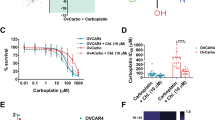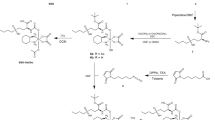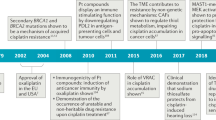Abstract
Acquired resistance to cisplatin (cis-diamminedichloroplatinum (II)) has been generated in vitro in the 41M human ovarian carcinoma cell line, established from a previously untreated patient. Three cisplatin-resistant variants were selected at approximately 2, 4 and 6-fold resistance (in terms of 50% inhibitory concentrations), in order to study the underlying mechanisms of acquired cisplatin resistance. Compared to the parent line, platinum accumulation following exposure to equimolar concentrations of cisplatin was on average (across the entire concentration range) 2.9, 3.6 and 4.8-fold lower in the 41McisR2, 41McisR4 and 41McisR6 cell lines, respectively. Thus the difference in uptake corresponded closely with their resistance factor in the three resistant variants. Moreover, a significant reduction in platinum accumulation was observed as early as 5 min after exposure to cisplatin in the 41M vs 41McisR6 cell lines. Platinum accumulation was similar in all cell lines following exposure to equitoxic concentrations (2 h IC50) of cisplatin. Enhanced efflux of drug was not observed between the 41M and 41McisR6 cells. In addition, there was no difference in intracellular glutathione (GSH) levels. Our previous studies have shown no indication of metallothionein involvement and the decrease in cisplatin uptake in the 41McisR6 cells was reflected by a similar reduction in DNA interstrand cross-links (ISC) formation. These results suggest that the mechanism of acquired resistance to cisplatin in the 41McisR6 cell line may be predominantly due to reduced drug uptake. The 41McisR6 cells were not found to be cross-resistant to ouabain, a postulated specific inhibitor of sodium-potassium adenosine triphosphatase (Na+, K(+)-ATPase), suggesting that decreased cisplatin accumulation in these cells is probably not regulated by alterations in their Na+, K(+)-ATPase levels, and Na+ potential across the plasma membrane. Cellular accumulation of a novel class of platinum (IV) ammine/cyclohexylamine dicarboxylates, which exhibit enhanced cytotoxicity over cisplatin and completely circumvent resistance to cisplatin in the 41McisR line, was also examined. The data suggests that increased accumulation of these compounds, as a result of their enhanced lipophilicity, could account for the dramatic increase in their potency over cisplatin.
This is a preview of subscription content, access via your institution
Access options
Subscribe to this journal
Receive 24 print issues and online access
$259.00 per year
only $10.79 per issue
Buy this article
- Purchase on Springer Link
- Instant access to full article PDF
Prices may be subject to local taxes which are calculated during checkout
Similar content being viewed by others
Author information
Authors and Affiliations
Rights and permissions
About this article
Cite this article
Loh, S., Mistry, P., Kelland, L. et al. Reduced drug accumulation as a major mechanism of acquired resistance to cisplatin in a human ovarian carcinoma cell line: circumvention studies using novel platinum (II) and (IV) ammine/amine complexes. Br J Cancer 66, 1109–1115 (1992). https://doi.org/10.1038/bjc.1992.419
Issue Date:
DOI: https://doi.org/10.1038/bjc.1992.419
This article is cited by
-
Fibroblast growth factor signalling influences homologous recombination-mediated DNA damage repair to promote drug resistance in ovarian cancer
British Journal of Cancer (2022)
-
Chloroxine overrides DNA damage tolerance to restore platinum sensitivity in high-grade serous ovarian cancer
Cell Death & Disease (2021)
-
Platinum(IV)-nitroxyl complexes as possible candidates to circumvent cisplatin resistance in RT112 bladder cancer cells
Archives of Toxicology (2017)
-
Anticancer and DNA Binding Activities of Platinum (IV) Complexes; Importance of Leaving Group Departure Rate
Applied Biochemistry and Biotechnology (2014)
-
Molecular mechanisms of cisplatin resistance
Oncogene (2012)



